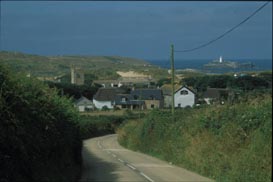Climate
histories of Cornwall
1700-1950
Michèle Clarke1, Georgina Endfield1, Alison Edgley2 & Mandy Morris3
1 School of Geography, University of Nottingham, University Park, Nottingham NG7 2RD.2School of Nursing, B Floor Queens Medical Centre, University of Nottingham, University Park, Nottingham NG7 2RD.
3 Cornish Audio Visual Archive (CAVA), Institute of Cornish Studies, University of Exeter in Cornwall
Coastal regions are particularly susceptible to changes in
Atlantic climate conditions with flooding, storms (Lamb &
Freydendahl,
1992), sand invasion (Lamb, 1995), droughts and intense frosts (Le Roy
Ladurie,
1971) causing problems for human settlement and agriculture. The North
Atlantic
Oscillation (NAO) is a large scale pattern of natural climate
variability
which has important impacts on the climate and weather of the North
Atlantic
region, and particularly Europe (Hurrell, 1995). The NAO controls the
location
and intensity (number of depressions) of storm tracks that impact upon
the
coastal areas of western Europe and it also controls spatial
temperature
and precipitation variability. Historical records of the NAO span the
period
from the present back to 1429 years AD. Through this time it is clear
that
the NAO has shown significant variability (Hurrell, 1995). The impact
of
these changes on society and livelihoods has been explored in Europe
through
records of Spanish shipwrecks (Garcia et al., 2000), storm records from
lighthouse
keepers in NW Scotland (Dawson et al., 2002) and through storm-driven
sand
drift causing village relocation and abandonment in Portugal (Clarke
&
Rendell, 2006) Spain (Borja et al., 1999) and France (Clarke et al.,
2002).
At present, little is known of the social, cultural, economic and
environmental
impacts of these climate changes on Britain.
This proposal seeks to address this gap
in
our understanding focusing on one area of Atlantic Britain, Cornwall,
where
a rich source of archive material remains unexploited for this purpose.
The
coastal areas of Cornwall have a long history of association with the
Atlantic
reflected in a cultural heritage of storm impacts involving shipwrecks,
building
damage, floods and sand invasion burying farmsteads, fields and
churches
(Murray, 1859; Lewis, 1992). Northwest facing coastal embayments are
highly
vulnerable to the full force of Atlantic climate extremes. This
research
will focus on three such localities: the Hayle Estuary and St Ives Bay
(8
parishes); Perranporth to Newquay (6 parishes); and the Camel Estuary
around
Padstow (10 parishes) where parochial accounts suggest climate extremes
were
known to prove problematic to settlements and livelihoods (Murray,
1859).
The period 1700-1950 is chosen as it spans from the Little Ice period
to
the present climatic amelioration.
This research, which is funded by a grant from the British Academy,
seeks to use archival sources and oral testimonies to:
• determine the nature and scale of the impacts of extreme
NAO winters on agricultural,
fishing and mining economies in communities
occupying
three Atlantic coastal embayments
• investigate human responses to changes in status of
the NAO in Cornwall, 1700-1950
• assess the vulnerability of different groups of society
in the area to climatic changes forced
by decadal shifts in status and extremes in annual
intensity of the NAO
• explore the impact of these events on respondents sense
of place and their local
communities.
Oral
testimonies will be faciliated through collaboration with CAVA who have
existing contacts with community groups and potential interviewees.
CAVA will also provide a
permanent home for the recorded interviews once the research is
finished and
these will be made available for public use at the Cornwall Centre in
Redruth
References
Borja et al. (1999) The Holocene, 9, 333-339;
Clarke, M.L, Rendell, H.M. (2006) The Holocene, 16 (3) in
press;
Clarke et al (2002) The Holocene, 12, 231-238;
Dawson et al. (2002) The Holocene, 12, 363-369;
García-Herrera et al (2000) Climate Research, 14, 147-151;
Hurrell, J.W. (2005) http://www.cgd.ucar.edu/cas/jhurrell/indices.html;
Lamb, H.H. (1995) Climate, History and the Modern World. 2nd
edition, Routledge, London;
Lamb, H.H., Frydendahl, K. (1991) Historic Storms of the North Sea,
CUP;
Le Roy Ladurie, E. (1971) Times of feast, times of famine: a
history
of climate since year 1000;
Lewis, D. (1992) In: Coastal dunes: geomorphology, ecology and
management for conservation;
Murray, J. (1859) Handbook for Travellers in Devon and Cornwall,
J.Murray, London;

